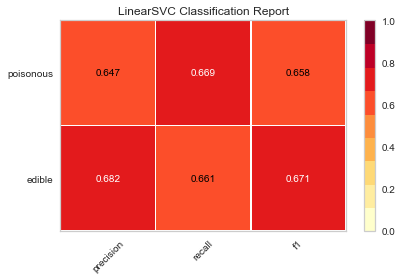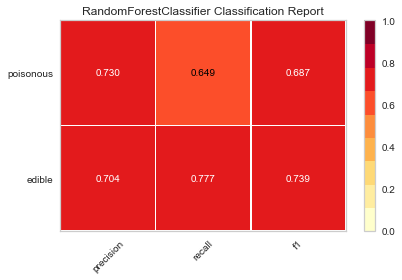Python机器学习之数据探索可视化库yellowbrick-tutorial
背景介绍
从学sklearn时,除了算法的坎要过,还得学习matplotlib可视化,对我的实践应用而言,可视化更重要一些,然而matplotlib的易用性和美观性确实不敢恭维。陆续使用过plotly、seaborn,最终定格在了Bokeh,因为它可以与Flask完美的结合,数据看板的开发难度降低了很多。
前阵子看到这个库可以较为便捷的实现数据探索,今天得空打算学习一下。原本访问的是英文文档,结果发现已经有人在做汉化,虽然看起来也像是谷歌翻译的,本着拿来主义,少费点精力的精神,就半抄半学,还是发现了一些与文档不太一致的地方。
# http://www.scikit-yb.org/zh/latest/tutorial.html
模型选择教程
在本教程中,我们将查看各种 Scikit-Learn 模型的分数,并使用 Yellowbrick 的可视化诊断工具对其进行比较,以便为我们的数据选择最佳模型。
模型选择三元组
关于机器学习的讨论常常集中在模型选择上。无论是逻辑回归、随机森林、贝叶斯方法,还是人工神经网络,机器学习实践者通常都能很快地展示他们的偏好。这主要是因为历史原因。尽管现代的第三方机器学习库使得各类模型的部署显得微不足道,但传统上,即使是其中一种算法的应用和调优也需要多年的研究。因此,与其他模型相比,机器学习实践者往往对特定的(并且更可能是熟悉的)模型有强烈的偏好。
然而,模型选择比简单地选择“正确”或“错误”算法更加微妙。实践中的工作流程包括:
选择和/或设计最小和最具预测性的特性集
从模型家族中选择一组算法,并且
优化算法超参数以优化性能。
模型选择三元组 是由Kumar 等人,在 2015 年的 SIGMOD 论文中首次提出。在他们的论文中,谈论到下一代为预测建模而构建的数据库系统的开发。作者很中肯地表示,由于机器学习在实践中具有高度实验性,因此迫切需要这样的系统。“模型选择,”他们解释道,“是迭代的和探索性的,因为(模型选择三元组)的空间通常是无限的,而且通常不可能让分析师事先知道哪个(组合)将产生令人满意的准确性和/或洞察力。”
最近,许多工作流程已经通过网格搜索方法、标准化 API 和基于 GUI 的应用程序实现了自动化。然而,在实践中,人类的直觉和指导可以比穷举搜索更有效地专注于模型质量。通过可视化模型选择过程,数据科学家可以转向最终的、可解释的模型,并避免陷阱。
Yellowbrick 库是一个针对机器学习的可视化诊断平台,它允许数据科学家控制模型选择过程。Yellowbrick 用一个新的核心对象扩展了Scikit-Learn 的 API: Visualizer。Visualizers 允许可视化模型作为Scikit-Learn管道过程的一部分进行匹配和转换,从而在高维数据的转换过程中提供可视化诊断。
关于数据
本教程使用来自 UCI Machine Learning Repository 的修改过的蘑菇数据集版本。我们的目标是基于蘑菇的特定,去预测蘑菇是有毒的还是可食用的。
这些数据包括与伞菌目(Agaricus)和环柄菇属(Lepiota)科中23种烤蘑菇对应的假设样本描述。 每一种都被确定为绝对可食用,绝对有毒,或未知的可食用性和不推荐(后一类与有毒物种相结合)。
我们的文件“agaricus-lepiota.txt”,包含3个名义上有价值的属性信息和8124个蘑菇实例的目标值(4208个可食用,3916个有毒)。
让我们用Pandas加载数据。
import os
import pandas as pd
mushrooms = 'data/shrooms.csv' # 数据集
dataset = pd.read_csv(mushrooms)
# dataset.columns = names
dataset.head()
| id | class | cap-shape | cap-surface | cap-color | bruises | odor | gill-attachment | gill-spacing | gill-size | ... | stalk-color-above-ring | stalk-color-below-ring | veil-type | veil-color | ring-number | ring-type | spore-print-color | population | habitat | Unnamed: 24 | |
|---|---|---|---|---|---|---|---|---|---|---|---|---|---|---|---|---|---|---|---|---|---|
| 0 | 1 | p | x | s | n | t | p | f | c | n | ... | w | w | p | w | o | p | k | s | u | NaN |
| 1 | 2 | e | x | s | y | t | a | f | c | b | ... | w | w | p | w | o | p | n | n | g | NaN |
| 2 | 3 | e | b | s | w | t | l | f | c | b | ... | w | w | p | w | o | p | n | n | m | NaN |
| 3 | 4 | p | x | y | w | t | p | f | c | n | ... | w | w | p | w | o | p | k | s | u | NaN |
| 4 | 5 | e | x | s | g | f | n | f | w | b | ... | w | w | p | w | o | e | n | a | g | NaN |
5 rows × 25 columns
features = ['cap-shape', 'cap-surface', 'cap-color']
target = ['class']
X = dataset[features]
y = dataset[target]
dataset.shape # 较官方文档少了俩蘑菇
(8122, 25)
dataset.groupby('class').count() # 各少了1个蘑菇
| id | cap-shape | cap-surface | cap-color | bruises | odor | gill-attachment | gill-spacing | gill-size | gill-color | ... | stalk-color-above-ring | stalk-color-below-ring | veil-type | veil-color | ring-number | ring-type | spore-print-color | population | habitat | Unnamed: 24 | |
|---|---|---|---|---|---|---|---|---|---|---|---|---|---|---|---|---|---|---|---|---|---|
| class | |||||||||||||||||||||
| e | 4207 | 4207 | 4207 | 4207 | 4207 | 4207 | 4207 | 4207 | 4207 | 4207 | ... | 4207 | 4207 | 4207 | 4207 | 4207 | 4207 | 4207 | 4207 | 4207 | 0 |
| p | 3915 | 3915 | 3915 | 3915 | 3915 | 3915 | 3915 | 3915 | 3915 | 3915 | ... | 3915 | 3915 | 3915 | 3915 | 3915 | 3915 | 3915 | 3915 | 3915 | 0 |
2 rows × 24 columns
特征提取
我们的数据,包括目标参数,都是分类型数据。为了使用机器学习,我们需要将这些值转化为数值型数据。为了从数据集中提取这一点,我们必须使用Scikit-Learn的转换器(transformers)将输入数据集转换为适合模型的数据集。幸运的是,Sckit-Learn提供了一个转换器,用于将分类标签转换为整数: sklearn.preprocessing.LabelEncoder。不幸的是,它一次只能转换一个向量,所以我们必须对它进行调整,以便将它应用于多个列。
有疑问,这个蘑菇分类就是一个向量?
from sklearn.base import BaseEstimator, TransformerMixin
from sklearn.preprocessing import LabelEncoder, OneHotEncoder
class EncodeCategorical(BaseEstimator, TransformerMixin):
"""
Encodes a specified list of columns or all columns if None.
"""
def __init__(self, columns=None):
self.columns = [col for col in columns]
self.encoders = None
def fit(self, data, target=None):
"""
Expects a data frame with named columns to encode.
"""
# Encode all columns if columns is None
if self.columns is None:
self.columns = data.columns
# Fit a label encoder for each column in the data frame
self.encoders = {
column: LabelEncoder().fit(data[column])
for column in self.columns
}
return self
def transform(self, data):
"""
Uses the encoders to transform a data frame.
"""
output = data.copy()
for column, encoder in self.encoders.items():
output[column] = encoder.transform(data[column])
return output
建模与评估
评估分类器的常用指标
精确度(Precision) 是正确的阳性结果的数量除以所有阳性结果的数量(例如,我们预测的可食用蘑菇实际上有多少?)
召回率(Recall) 是正确的阳性结果的数量除以应该返回的阳性结果的数量(例如,我们准确预测了多少有毒蘑菇是有毒的?)
F1分数(F1 score) 是测试准确度的一种衡量标准。它同时考虑测试的精确度和召回率来计算分数。F1得分可以解释为精度和召回率的加权平均值,其中F1得分在1处达到最佳值,在0处达到最差值。
precision = true positives / (true positives + false positives)
recall = true positives / (false negatives + true positives)
F1 score = 2 * ((precision * recall) / (precision + recall))
现在我们准备好作出一些预测了!
让我们构建一种评估多个估算器(multiple estimators)的方法 —— 首先使用传统的数值分数(我们稍后将与Yellowbrick库中的一些可视化诊断进行比较)。
from sklearn.metrics import f1_score
from sklearn.pipeline import Pipeline
def model_selection(X, y, estimator):
"""
Test various estimators.
"""
y = LabelEncoder().fit_transform(y.values.ravel())
model = Pipeline([
('label_encoding', EncodeCategorical(X.keys())),
('one_hot_encoder', OneHotEncoder(categories='auto')), # 此处增加自动分类,否则有warning
('estimator', estimator)
])
# Instantiate the classification model and visualizer
model.fit(X, y)
expected = y
predicted = model.predict(X)
# Compute and return the F1 score (the harmonic mean of precision and recall)
return (f1_score(expected, predicted))
from sklearn.svm import LinearSVC, NuSVC, SVC
from sklearn.neighbors import KNeighborsClassifier
from sklearn.linear_model import LogisticRegressionCV, LogisticRegression, SGDClassifier
from sklearn.ensemble import BaggingClassifier, ExtraTreesClassifier, RandomForestClassifier
model_selection(X, y, LinearSVC())
0.6582119537920643
import warnings
warnings.filterwarnings("ignore", category=FutureWarning, module="sklearn") # 忽略警告
model_selection(X, y, NuSVC())
0.6878837238441299
model_selection(X, y, SVC())
0.6625145971195017
model_selection(X, y, SGDClassifier())
0.5738408700629649
model_selection(X, y, KNeighborsClassifier())
0.6856846473029046
model_selection(X, y, LogisticRegressionCV())
0.6582119537920643
model_selection(X, y, LogisticRegression())
0.6578749058025622
model_selection(X, y, BaggingClassifier())
0.6873901878632248
model_selection(X, y, ExtraTreesClassifier())
0.6872294372294372
model_selection(X, y, RandomForestClassifier())
0.6992081007399714
初步模型评估
根据上面F1分数的结果,哪个模型表现最好?
可视化模型评估
现在,让我们重构模型评估函数,使用Yellowbrick的ClassificationReport类,这是一个模型可视化工具,可以显示精确度、召回率和F1分数。这个可视化的模型分析工具集成了数值分数以及彩色编码的热力图,以支持简单的解释和检测,特别是对于我们用例而言非常相关(性命攸关!)的第一类错误(Type I error)和第二类错误(Type II error)的细微差别。
第一类错误 (或 "假阳性(false positive)" ) 是检测一种不存在的效应(例如,当蘑菇实际上是可以食用的时候,它是有毒的)。
第二类错误 (或 “假阴性”"false negative" ) 是未能检测到存在的效应(例如,当蘑菇实际上有毒时,却认为它是可以食用的)。
from sklearn.pipeline import Pipeline
from yellowbrick.classifier import ClassificationReport
def visual_model_selection(X, y, estimator):
"""
Test various estimators.
"""
y = LabelEncoder().fit_transform(y.values.ravel())
model = Pipeline([
('label_encoding', EncodeCategorical(X.keys())),
('one_hot_encoder', OneHotEncoder()),
('estimator', estimator)
])
# Instantiate the classification model and visualizer
visualizer = ClassificationReport(model, classes=['edible', 'poisonous'])
visualizer.fit(X, y)
visualizer.score(X, y)
visualizer.poof()
visual_model_selection(X, y, LinearSVC())

# 其他分类器可视化略
visual_model_selection(X, y, RandomForestClassifier())

检验
现在,哪种模型看起来最好?为什么?
哪一个模型最有可能救你的命?
可视化模型评估与数值模型评价,体验起来有何不同?
准确率Precision召回率Recall以及综合评价指标F1-Measure
http://www.makaidong.com/博客园热文/437.shtml
f1-score综合考虑的准确率和召回率。
可视化就是直观嘛,逃~
作者简介
知乎yeayee,Py龄5年,善Flask+MongoDB+SKlearn+Bokeh


 浙公网安备 33010602011771号
浙公网安备 33010602011771号